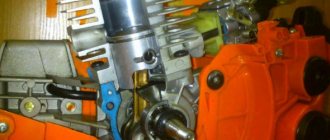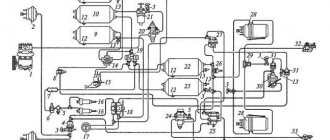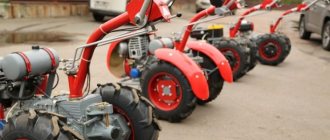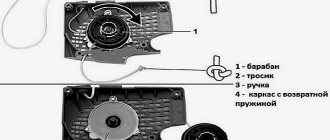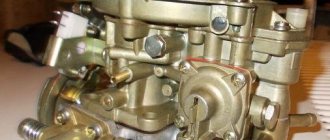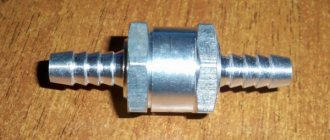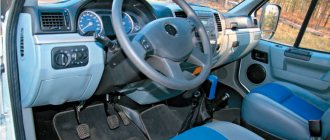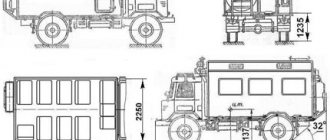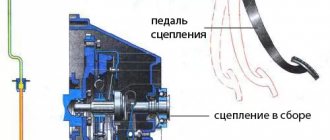The semi-trailer braking system is an important component of the semi-trailer. Let's take a look at how the brake system of a semi-trailer works and what it consists of.
First of all, we note that modern semi-trailers use a pneumatic braking system, in which the energy of compressed air is used for braking, and the operation of the system itself is associated with the interaction of many actuating and control elements. Therefore, if you need to check the technical condition of the pneumatic braking system of a semi-trailer, you need to understand how the entire system is structured and how it functions. Let us dwell on this point in detail.
Semi-trailer braking system. Construction details
In a pneumatic braking system, the drive occurs using the energy of compressed air. The drive refers to all elements and mechanisms located between the brake and the control element, ensuring the operation of the semi-trailer braking system.
The drive is usually divided into two parts:
The drive parts do not consider the supply and control lines that connect the semi-trailer and the towing vehicles.
The control drive refers to the drive elements that operate the brakes and also control the supply of the required energy.
An energy drive is a system that supplies energy to the brakes, which is necessary for their operation and the operation of all braking mechanisms.
A brake is a mechanism in which the resulting forces counteract the movement of vehicles.
General principle of operation of the brake pneumatic system.
In a simplified way, the principle of operation can be described as follows. air pump - a compressor driven by an engine pumps air into the system from the atmosphere. Thanks to the pressure regulator, the system creates and maintains the required air pressure. The supply of air compressed by the compressor is accumulated in special cylinders - receivers, attached to the frame of the vehicle. When the driver presses the brake pedal, air from the receivers through tubes and hoses fills the brake chambers. The chambers operate the brake pad mechanisms with their rods. Brake pads transfer the energy of compressed air to the brake drums (discs) of the wheels. Traffic slows down. When the driver releases the brake pedal, air from the brake chambers returns to the atmosphere. The mechanical parts of the system return to their original position using built-in springs. The car picks up speed again.
Semi-trailer braking system. Kinds
The brake can be of several types, depending on what causes these forces:
- Friction brake. The generation of force in it occurs due to the friction of two moving parts relative to each other. The elements of such a brake are called brake mechanisms.
- Electric brake. Force arises from the influence of electromagnets on each other without direct contact.
- Hydraulic brake. The emergence of a counteracting force occurs under the action of a fluid that is located between parts of the vehicle moving relative to each other.
- Engine brake. The origin of the force is due to the fact that the braking effect on the engine occurs through artificial interaction, which is transmitted to the wheels.
- And finally, the semi-trailer pneumatic braking system.
Pneumatic braking system for semi-trailer
In the pneumatic braking system of a semi-trailer, the control drive is the components of the pneumatic drive itself, which transmit a signal to the controlled or automatic operation of the power drive parts. The number four on the pneumatic drive control elements (regulators, valves, brake valves, etc.) indicates the input of the pneumatic control signal. On the functional and block diagrams you can see the same meaning of this signal.
In the pneumatic braking system of a semi-trailer, the energy drive is the elements of the pneumatic drive, due to which the parts of the control drive or energy drive (pneumatic cylinders, energy accumulators, brake chambers, etc.) are supplied with compressed air. The number one on the pneumatic drive control elements indicates the input of the supply line. In some cases, the functions of the supply can be performed by a control signal. But even in this case, the input of this signal on the diagrams and elements of the pneumatic drive will be marked with the number one.
The number two on diagrams and controls always indicates any output signal.
If the control elements contain not one, but many outputs and inputs, then they are marked in ascending order from the original designation (for example: 9,10 or 18,19).
On the brake drive elements, the number three means connection with the atmosphere.
Semi-trailer braking system. Operation
Let's consider the functioning of the braking system of a semi-trailer using the example of a cargo vehicle used to tow a semi-trailer.
The pneumatic drive of a semi-trailer is usually divided into several circuits that are independent of each other. This was done to ensure safety. The first circuit is the supply circuit, designed to prepare compressed air for the pneumatic system.
Compressor – is a pump for air that forces it into the supply circuit. Also performs initial pressure regulation.
The pressure regulator performs the function of maintaining the pressure of compressed air in the compressor within the required limits.
What does a dehumidifier do? Air dryer – prepares compressed air for the pneumatic system. Its main task is to remove water vapor from the air and filter unnecessary impurities, such as oil vapor. Modern dryers simultaneously perform both the function of filtering impurities and the function of regulating pressure, which is why there is no separate unit for a pressure regulator. Since many dehumidifiers operate on the principle of regeneration, they have a separate receiver for performing the regenerative function.
Semi-trailer braking system. Scheme
Semi-trailer braking system diagram
Semi-trailer braking system. Processes
After the compressed air passes through the dryer, it flows to the 4-circuit safety valve. What are the functions of this device? Here's what the safety valve does:
— divides the compressed air flow into different circuits;
— ensures that the circuits are filled with compressed air in a sequential order after achieving the required pressure in the primary circuit;
— when the pressure decreases or one of the circuits depressurizes, it ensures the sealing of all remaining circuits.
After air passes through the 4-circuit valve, it is distributed to the remaining circuits:
— along two circuits of the service brake system independent of each other (1 and 2);
— along the circuit of the emergency parking brake system, and along the control and supply circuits of the semi-trailer;
- along the supply circuit of the air suspension itself and other air consumers (in Fig. No. 9), such as the pneumatic hydraulic clutch, driver's seat, cabin air suspension.
This is how a semi-trailer braking system works on a semi-trailer. To perform the function of influencing the braking system, there are actuators on each circuit, and for connection with the supply and control lines of the tractor, connecting heads are located on the circuit of the semi-trailer braking system.
In the first and second circuits of the semi-trailer brake system, the air, passing through the receivers, goes to the brake valve in the lower and upper sections. Inside this element, either a combined (supplying and at the same time controlling) or only a control signal is formed, which is transmitted immediately (we look at the image of the front wheel brakes), or passes first through the control elements (we look at the image of the rear wheel brakes) to the actuating elements of the brake system ( 20 and 14). Brake force regulators, relay accelerator valves can also act as additional control elements that ensure the operation of brake release valves, accelerator valves, etc. Brake chambers combined with an energy accumulator, or simple diaphragm brake chambers can serve as actuating elements.
In the third circuit, the air approaches the hand brake valve of the parking and emergency brake mechanisms, where usually the formation of a control signal goes to the 17th accelerator valve of the emergency brake system, where pressure is released or supplied from the brake combined chamber, from the energy accumulator section. The power supply to the valve that controls the brake mechanism of the semi-trailer also comes from this circuit. This valve supplies air to the brake mechanism of the semi-trailer through the connecting heads, and it also generates a control signal that comes from the brake valves of the parking, service and emergency brake systems.
To monitor the entire braking system of a semi-trailer, measuring instruments are attached to it. This is either one common monometer for everyone, or several monometers measuring pressure in the first and second circuits. There are also control lights to signal changes in pressure in the pneumatic drive.
The tractor has ABS (anti-lock braking system) components connected to the pneumatic system, which implement this function for the entire vehicle. The system contains sensors that analyze the angular speed of the wheels, modulators (electromagnetic valves) that perform the function of actuators, a control unit for analyzing sensor signals, diagnostic and control lamps that transmit a signal about those conditions, and a semi-trailer connecting plug.
The semi-trailer is supplied with compressed air through a red connection head. Air is forced into the receiver, passing through the filter and through the brake valve.
Description of the main working elements of the brake pneumatic system.
- Compressor. Air pump. pumps air into the pneumatic system.
- Pressure regulator. Maintains the specified operating pressure in the system and limits the flow of excess air.
- Air Dryer. Retains moisture and other impurities to prevent them from entering the system mechanisms.
- Four-circuit safety valve. Distributes air through independent circuits and prevents air leakage in the event of a break in one of them.
- Circuit receivers. Special cylinders for accumulating compressed air reserves.
- Foot brake valve. Designed to control the service brake system.
- Brake chambers. convert air pressure into a mechanical braking process.
- Manual brake valve. Provides control of the parking brake system.
- Energy accumulators. They act as actuators and brake the vehicle while it is parked, as well as while moving, when the pressure in the pneumatic system drops below the permissible level.
- Anti-lock braking system parts. Control the process of uniform wheel braking.
- Pressure gauge. A device on the panel in front of the driver with pressure readings in the system.
- Control and emergency signaling devices. Indicator lights on the panel.
About the manufacturer
Wabco has been providing high levels of commercial vehicle safety for a century and a half. The creator continues to develop and discover new technologies in the production of electronics for braking systems.
Wabco presented the first of its achievements:
- anti-lock braking device (1981);
- electronic braking system (1996);
- electronic-pneumatic drive device with a hybrid drive (2012).
And this is not a complete list of merits. Slowly but surely the company took a leading position among its competitors. Today, Wabco has offices in forty countries with thousands of employees.
Detailed information is visible in the video:
When to turn to professionals
Owners of Krone semi-trailers bring their equipment to a service center or service station when the first signs of a component or unit malfunction appear:
- problems with longitudinal stability;
- the appearance of wobbling in different directions above acceptable standards;
- problems with the brake system;
- the presence of excessive vertical vibrations during movement of an empty cargo compartment.
The presence of digital equipment and special tools allows you to diagnose, identify the cause and eliminate it in a short time. This approach reduces transport downtime and reduces financial costs for vehicle repairs.
General characteristics of the braking system
The Wabco semi-trailer brake system consists of high quality materials. Spare parts undergo mandatory testing.
Advantages of Wabco brakes:
- keep the loaded trailer in a safe position during stops;
- slow down vehicles without sliding as much as possible;
- optimize braking distance;
- have functional air suspension;
- installed on all types of trailers and semi-trailers;
- capable of conducting intelligent analysis of information and then converting it into functions, of which there are more than 40.
Wabco auto parts are numbered. An example is shown in the figure.
The numbers consist of 10 digits (in the figure they are labeled 2,3,4).
- The numbers indicate the date of manufacture.
- Six digits determine the type of device.
- Indicates an option.
- Indicates the condition of the spare part.
In the picture, the condition of the spare part is indicated as 0. The number indicates that the part is new.
Here are the values for other numbers that can be specified instead of 0:
- 1 – the device is new, but not completely, but only part of it;
- 2 – indicates a repair kit or assembly unit;
- 4 and 7 – accessories and spare parts, respectively.
The numbers 001 in the figure indicate the original part number.
Components
- Wabco semi-trailer brake valve. Provides pneumatic and electrical signals that correspond to the required deceleration value;
- Wabco control unit. Controls the brakes;
- acceleration valve. Regulates pressure in the front axle;
- braking unit. It is a combination of a brake valve, a control unit and a proportional accelerator valve;
- semi-trailer brake control valve. Regulates the pressure output at the locations where the connection heads are located;
- pressure regulator. Controls the force of air pressure in the pneumatic system.
Load distribution scheme
These are technical requirements that regulate the pressure on the axles of semi-trailers. After all, the less the load on the drive axle of the tractor, the worse the adhesion of the wheels to the road surface. Exceeding the permitted limits may result in damage to the mechanisms.
The cargo distribution scheme includes:
- setting the transport position using supports and recesses;
- if a heavy load is not located at the end of the body, then special insert racks, guides, belts with ring loops, fixing stops, and additional partitions are used;
- a certain location of the center of gravity relative to the center of the PP.
The load distribution diagram shows at what distance from the front wall of the semi-trailer it is permissible to place the maximum load.
In case of any malfunction of the Schmitz software, it is better to transfer it to an authorized center for repair. But when there is no service nearby, the diagrams of the main systems are used to look for a node with a failure, and watch a video with repair tips. Based on this material, the malfunction is eliminated. As a result, it becomes possible to get to professional help.
Malfunctions
Breakdowns occur in any technology. Wabco brake systems can detect them quickly. Especially if the trailer is connected to EBS. The system is capable of self-testing and detecting faults.
Signs
You can see the breakdown by the following signs:
- continuous operation of the air compress, during which air is constantly pumped into the system;
- lit buttons on the dashboard that indicate problems;
- strange knocking in brakes and tires, squeaking;
- untimely braking;
- the tendency of vehicles to skid when braking.
Causes
The appearance of one of the above symptoms indicates that the Wabco system has failed. At this stage, it is important to find the cause of the breakdown.
- failure of EBS or ABS;
- improper operation of transport;
- self-repair (for example, some try to repair the brakes on a Schmitz or Krone trailer, reading advice from various forums);
- lack of regular maintenance.
Troubleshooting
Repairs must be carried out only at specialized service stations. Troubleshooting yourself may damage the system even more.
Lack of technical inspection and untimely repairs lead to:
- emergency situation in case of brake failure, increasing braking distance;
- brake failure;
- malfunction of electronics.
Specialized service stations offer:
- diagnostics of faults in trailed ABS, ESB, pneumatic braking systems from Wabco;
- repair of the brake release valve;
- searching for faulty sensors;
- search for non-working semi-trailer cranes;
- setting braking parameters;
- firmware of a working TABS-E WABCO modulator, etc.
Causes of breakdowns
This is metal fatigue, improper operation or late preventive inspection, poor quality of roads.
Normal operation of semi-trailers may be disrupted for the following reasons:
- premature wear of parts;
- installation of non-original spare parts;
- overload during transportation;
- improper distribution of load;
- loosening of fasteners;
- leaks of air and liquids from systems.
These types of failures are eliminated during planned and regular maintenance, and diagnostics of breakdowns, their timely detection and correction help maintain equipment in normal condition.
Attention! By performing preventive inspections before each flight, the driver prevents possible failures on the road.
You cannot ignore any deviations in the proper operation of even small parts, because such a breakdown at speed can cause an accident. By being negligent, a truck driver endangers the cargo, life and health of other road users.
